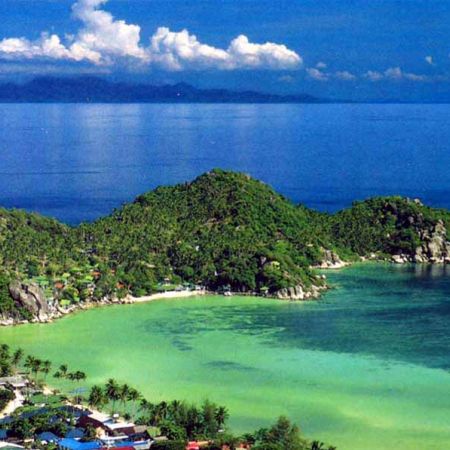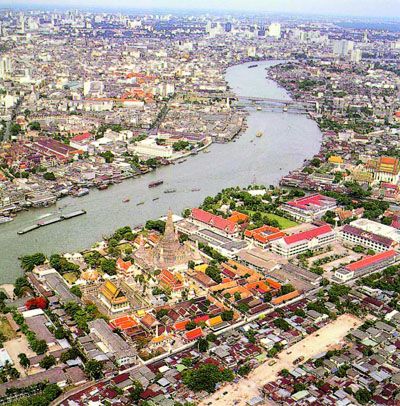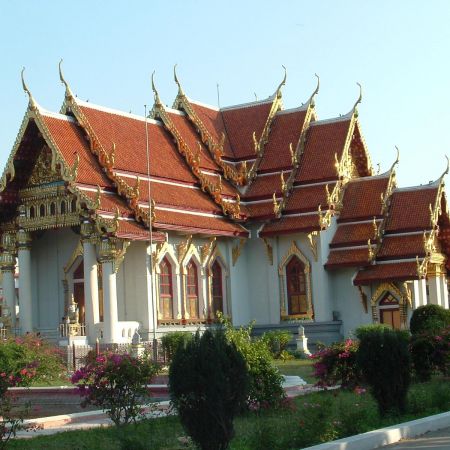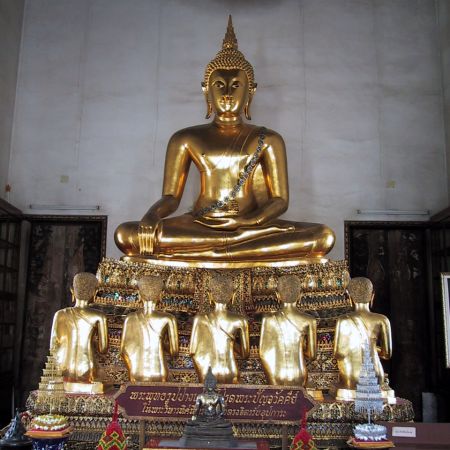The best cultures and backgrounds makes Thailand an interesting and memorable country to visit. More people visit Thailand than any other country in Southeast Asia. This is no surprise as the Royal Kingdom of Thailand has much to offer for the visitor: historic culture, lively arts, beautiful beaches, a good nightlife, friendly and hospitable people and last but not least one of the best cuisines in the world. Travel in Thailand is easy due to a good network of trains, busses and airplanes. Most visitors enter the country via the Southeast Asian travel hub Bangkok, the City of Angels. From there you can do great daytrips to cities like the former capital Ayutthaya and Kanchanaburi , known for the River Kwai bridge. Popular beach islands include Koh Samui and Phuket Island. Chiang Mai in Northern Thailand is popular for Thai culture and scenary.
From there most visitors head either north or south. In the north you can visit the interesting cities of Sukhothai , Chiang Mai , Chiang Rai or Mae Hong Son . The north is known for its fantastic trekking possibilities, the interesting hill tribes, and its gentle Lanna culture. In the south the traveler can relax at some of the most beautiful beaches in the world, for example, Koh Tao, Krabi, Koh Samui or Phuket or Trang. Some areas are very touristy, but it is easy to find some quiet spots. A little closer to Bangkok there is the resort town of Hua Hin and Khao Takiab Beach in Hua Hin, very popular as beaches close to Bangkok, Hua Hin which is home to one of the most used Palaces. Cha Am is also a popular beach area close to Bangkok just north of Hua Hin.
The Northeast is popular with independent travelers. Known by Thais as Isaan this area hosts some lovely forested mountains and national parks and very friendly people. The major highlight is probably the famous Khao Yai national park , but other interesting places are easily found in this area including Nong khai and Surin.
People with a limited time budget might go to the East Coast. There are many popular resorts, including Pattaya and Jomtien. The region is rich in natural resources, including rubber, rice, fishing, orchards and gemstones, and scenically arresting with several national parks containing waterfalls, virgin forest and uninhabited, remote islands. Popular islands locations are Ko Chang and Ko Samet.

HISTORY
Southeast Asia has been inhabited for more than half a million years. Recent archaeological studies suggest that by 4000 B.C. communities in what is now Thailand had emerged as centers of early bronze metallurgy. This development along with the cultivation of wet rice provided the impetus for social and political organization. Research suggests that these innovations may actually have been transmitted from there to the rest of Asia including to China. The Thai are related linguistically to groups originating in southern China. Migrations from southern China to Southeast Asia may have occurred in the 6th and 7th centuries. Malay Mon and Khmer civilizations flourished in the region prior to the arrival of the ethnic Thai.
Thais date the founding of their nation to the 13th century. According to tradition in 1238 Thai chieftains overthrew their Khmer overlords at Sukhothai and established a Thai kingdom. After its decline a new Thai kingdom emerged in 1350 on the Chao Praya River.
The first ruler of the Kingdom of Ayutthaya King Rama Thibodi made two important contributions to Thai history: the establishment and promotion of Theravada Buddhism as the official religion (to differentiate his kingdom from the neighboring Hindu kingdom of Angkor) and the compilation of the Dharmashastra a legal code based on Hindu sources and traditional Thai custom. The Dharmashastra remained a tool of Thai law until late in the 19th century. Beginning with the Portuguese in the 16th century Ayutthaya had some contact with the West but until the 1800s its relations with neighboring nations as well as with India and China were of primary importance.

After more than 400 years of power in 1767 the Kingdom of Ayutthaya was brought down by invading Burmese armies and its capital burned. After a single-reign capital established at Thonburi by Taksin a new capital city was founded in 1782 across the Chao Phraya at the site of present-day Bangkok by the founder of the Chakri dynasty. The first Chakri king was crowned Rama I. Rama's heirs became increasingly concerned with the threat of European colonialism after British victories in neighboring Burma in 1826. The first Thai recognition of Western power in the region was the Treaty of Amity and Commerce with the United Kingdom in 1826. In 1833 the United States began diplomatic exchanges with Siam (as Thailand was called until 1938). However it was during the later reigns of Rama IV (or King Mongkut (1851-1868)) and his son Rama V (King Chulalongkorn (1868-1910)) that Thailand established firm reapprechment with Western powers. The Thais believe that the diplomatic skills of these monarchs combined with the modernizing reforms of the Thai Government made Siam the only country in South and Southeast Asia to avoid European colonization.
In 1932 a bloodless coup transformed the Government of Thailand from an absolute to a constitutional monarchy. King Prajadhipok (Rama VII) initially accepted this change but later surrendered the kingship to his 10-year old nephew. Upon his abdication King Prajadhipok said that the obligation of a ruler was to reign for the good of the whole people not for a select few. Although nominally a constitutional monarchy Thailand was ruled by a series of military governments interspersed with brief periods of democracy from that time until the 1992 elections. Since the 1992 elections Thailand has been a functioning democracy with constitutional changes of government. As with the rest of Southeast Asia Thailand was occupied by the Japanese during the Second World War. Since Japan's defeat in 1945 Thailand has had very close relations with the United States. Threatened by communist revolutions in neighboring countries such as Burma Vietnam Cambodia and Laos Thailand actively sought to contain communist expansion in the region. Recently Thailand also has been an active member in the regional Association of South East Asian Nations (ASEAN).
Bangkok : Thailand's capital city is a fantastic place to visit. It is the travel hub for the whole Southeast Asian region and a must. Most people come back and forth if they visit the different regions of Thailand, for example Chiang mai, Koh Samui or Phuket or Trang. Its bad reputation for long traffic jams and pollution is no longer justified. At the end of 2000, the new BTS Sky Train went into service and new roads have been built. To get around there is also now the MRT metro (underground railway), which serves a number of locations in the centre of the city. In comparison to other mega-cities, Bangkok is also a very safe city and has one of the lowest crime rates in the world.



































